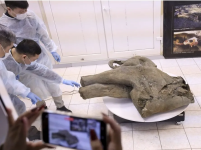Squirrels were filmed feasting on tiny rodents. Scientists are perplexed.
Author of the article:Washington Post
Washington Post
Kyle Melnick
Published Dec 24, 2024 • 4 minute read
First, the predators ripped off the rodents’ heads. Then they dug their teeth into their prey’s torsos, feasting on meat, organs and cartilage.
The predators? Squirrels, the populous mammals who have long been known to mostly eat nuts, seeds and plants.
While studying ground squirrels in Northern California this past summer, biologists expected to observe the animals banding together to forage for grass seeds and walnuts and avoid predators. But what they saw shocked them: Despite an abundance of their main food sources, the squirrels also hunted and ate small rodents called voles.
The researchers said their study, published Wednesday in the Journal of Ethology, marked the first widespread observation of squirrels hunting another mammal and showed that squirrels don’t only stalk prey when they’re out of other food options.
“Never in a million years did I ever anticipate squirrels to become avid hunters with a taste for meat,” Jennifer Smith, the study’s lead author, said in an email to The Washington Post.
Smith, an associate biology professor at the University of Wisconsin at Eau Claire, has been studying squirrels’ genetics, behaviors and stress responses at Briones Regional Park in Contra Costa County, California for 12 years. The area features an open grassland, walnut and oak trees and scenic trails.
The research – conducted by biologists and students at the University of Wisconsin at Eau Claire and the University of California at Davis – has consisted of baiting squirrels to caged traps with peanut butter and sunflower seeds, recording their gender, body mass and reproductive status and placing metal tags on their ears. Researchers have trapped and released 1,337 different squirrels, Smith said.
Studying hunting behavior wasn’t part of the plan until early June, when two University of Wisconsin at Eau Claire undergraduate students filmed a squirrel chasing and attempting to kill a vole – unsuccessfully – at Briones Regional Park. When the students told Sonja Wild, a postdoctoral research fellow at the University of California at Davis, she was skeptical.
When she watched the video, however, Wild said she could hardly believe her eyes.
Squirrels have been found to eat insects, meat from carcasses, eggs and young birds. Female squirrels sometimes eat their own babies. Squirrels have also been seen occasionally preying on small animals, such as lizards, lemmings and snowshoe hares. But the researchers said squirrels are rarely spotted hunting.
“Seeing the squirrels that you normally observed foraging on grasses and seeds chasing voles across the landscape was a little shocking but pretty spectacular,” Wild said in an email.
For the remainder of June and most of July, the researchers witnessed squirrels hunting voles nearly every day they observed the mammals, Wild said. The researchers sat at least 21 yards from squirrels – to avoid scaring them – and watched them through binoculars. They filmed squirrels with their phones and a Canon camera.
The researchers observed squirrels – of both genders and of a wide age range – hunting voles 31 times, including 17 kills. Voles were most hunted near squirrels’ burrows, leading the researchers to believe voles were seeking safety in the burrows when squirrels encountered them.
Most of the time, squirrels chased voles across the dirt landscape. If squirrels came close to their prey, they usually pounced on it with their paws and teeth. Other times, squirrels squatted and approached stealthily before launching themselves at voles. Squirrels typically bit a vole’s neck to kill it.
But a major question remained: What caused squirrels to hunt voles? A large increase in vole population in California this summer prompted the unusual behavior, according to Smith and Wild.
Vole populations peak every four to eight years in many areas before rapidly declining, according to the University of California’s pest management program. Smith and Wild said 2024 was a peak year, and squirrels saw the abundance of voles as another source of high-energy meals.
Cory Williams, an associate biology professor at Colorado State University who wasn’t involved in the study, supported the researchers’ theory, telling The Post that ground squirrels sometimes eat small mammals when that species sees a population boom.
“Because it’s so foreign to us, it seems like super crazy,” Williams said of squirrels hunting. “But it’s one of those things when you’ve got a species out there that can take advantage of something like this, you know, they will do so.”
Briones Regional Park’s squirrels will probably return to their normal diets after the vole population returns to normal, Smith said, but there are other ways eating voles could impact the local squirrel population.
Squirrels are mostly income breeders, meaning they can produce more offspring if they eat more, so Smith wonders if eating voles could cause squirrels to have more babies. She has other unanswered questions, such as how widespread hunting is among squirrels and if they earn to hunt by nature or nurture.
“It will be exciting to see what happens next,” Smith said, “and if, given their new found taste for meat, squirrels target other animals in the future.”
12-23-2024 08:35PM
Scientists are perplexed.

torontosun.com

 torontosun.com
torontosun.com












